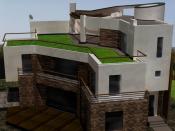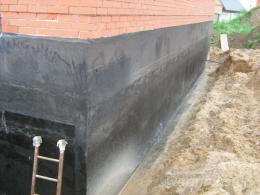Search
Login
DIY waterproofing at home
When, after the appearance of dampness, examining the reason, they come to the conclusion that the waterproofing (waterproofing laying) between the foundation and the building is broken, or it was not laid at all initially, the only solution to the problem is laying a new waterproofing.
Content
- Causes of Rising Dampness
- Traditional waterproofing
- Porous tubes
- Electroosmotic method of waterproofing
- Wall preparation for chemical waterproofing
- Chemical waterproofing injection
- Security measures
Causes of Rising Dampness
The easiest way is to invite professionals to identify the causes of rising dampness (dampness that comes from the baseboard up the wall).
But you can independently check the condition of the walls using an inexpensive electric device - a moisture meter. Indoors, along the entire length of the wall and from the floor to a height of about 1 meter, at regular intervals, read the moisture meter.
If there is rising damp, the device shows high humidity, the value of which drops sharply above a height of 1 meter.
Dampness and condensation appears as individual wet spots or humidity along the entire wall.
If you have any suspicions of rising dampness, you need to check if there is a bridge that bridges a good waterproofing before spending money on installing a new gasket.
Check the plaster, as salt-saturated plaster can be a source of rising humidity.
Traditional waterproofing
Usually, as a waterproofing pad, a layer of waterproof material is placed on the foundation at a height of about 150 mm. (Two to three bricks) above the ground.
New waterproofing can be installed in an existing wall, for this solution is cut out from the masonry seam with a chainsaw or grinder. A sheet of copper or rolled roofing material is inserted into the cut place, then the seam is wedged and filled with a fresh solution.
In the production of such work, experience is needed to avoid weakening the masonry walls.
In addition, there is a danger of running into a water pipe or wiring, especially if the house is old and you did not participate in its construction.
Porous tubes
There is a second way to repair waterproofing. With this method, horizontally in a row, close to each other, holes are drilled into which porous clay tubes are inserted, they prevent the rise of moisture too high. This is the most simple and inexpensive tool.
Electroosmotic method of waterproofing
With this method, the property of weak electric fields is used, which prevents the liquid from rising through the capillaries.
A groove is made around the entire perimeter of the house at the waterproofing level, a titanium wire is laid in it (when laying, the loops are bent, they play the role of the anode and are inserted into the hole, which are drilled in the masonry with equal intervals).
The wire connects to ground, and the system power supply plugs into a standard power outlet. Then the wire, holes and groove are sealed with mortar.
This type of waterproofing can be done both outside and inside, but only a specialist should do this.
Wall preparation for chemical waterproofing
The chemical waterproofing method involves the injection of a waterproof chemical (silicone), it creates a continuous barrier across the entire thickness of the wall.
This method is quite simple, you can do it yourself by renting equipment, it is used for brick or stone walls, up to 60 cm thick.
If you decide to do the work yourself, rent a compressor to inject liquid waterproofing.
Get a waterproofing fluid, considering that for every 30 meters of the wall, up to 250 mm thick., From 70 to 100 liters will be required.
Before the work is done, it is necessary to cut the plaster to a height of 50 cm above the visible dampness, remove the baseboard, repair the masonry, and make the joints.
At a height of 150 mm. above ground level outside the wall, but below the level of the wooden floor, and if the floor is concrete, monolithic, then drill a series of holes just above its level
If there is an old waterproofing, try not to damage it when drilling, drill a little higher than the old one.
In order to get continuous waterproofing, for a wall 250 mm thick. and more, drill the same holes on both sides of the wall. Place the holes at intervals of 110 mm. about 25 mm. below the top edge of the brick row, with the holes slightly tilted down.
Make the depth of the holes equal to 75-85 mm. on both sides, but if only one side is drilled, then their depth should be up to 200 mm.
If the wall is made in the form of lightweight masonry, then drill each wall of the wall individually, making holes with a depth of 75 mm.
If the wall is made of waterproof stone blocks, then cement joints are drilled around each block at the level of supposed insulation with an interval of 75 mm.
Chemical waterproofing injection
Most compressors operate on the same principle: the suction hose with a filter is lowered into a container with liquid, closing the nozzle valves, the compressor is connected to the network. After connecting the nozzles to the hoses (usually from 3 to 6 pieces), insert the nozzles into the holes in the wall if you are processing a thick wall in which holes 75 mm deep are made. - use shorter nozzle tips.
The nuts are tightened well to securely and tightly fasten the nozzles, then the valves on all nozzles except the far one open, the compressor is turned on, so that the liquid begins to circulate.
To remove air from the system, the valve of the last nozzle opens and a little liquid is drained through it.
Turn off the compressor and insert this nozzle into the wall. Then open the valve and let the liquid flow until it moistens the surface of the bricks. Using the pressure regulator that is installed on the compressor housing, keep the pressure between 3.5 and 5.6 bar. The pressure can be lower, this is specified in the equipment manual and depends on the condition and age of the masonry.
Then all the valves are closed, the nozzles are rearranged and the procedure is repeated. Having reached the end of the wall, turn off the compressor and returning to the beginning, drill holes to a depth of 190 mm. Change the short nozzles to 190 mm., Insert them into the wall and inject liquid. At the end of the operation, flush the compressor with white spirit.
Security measures
The rental company will provide training on the safe handling of chemicals and equipment.
When working, use all personal protective equipment, at least you must wear protective gloves, goggles and a mask.





